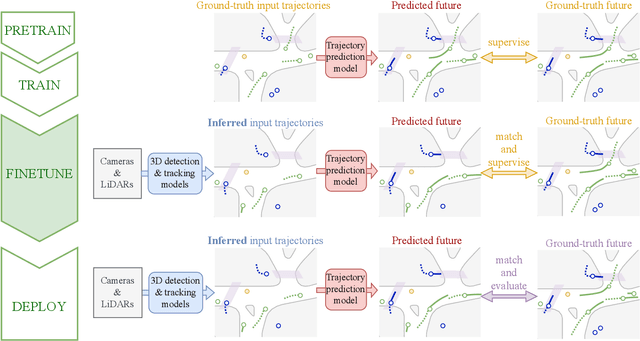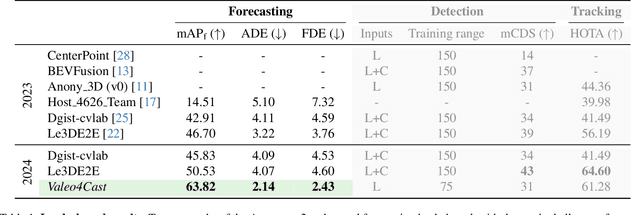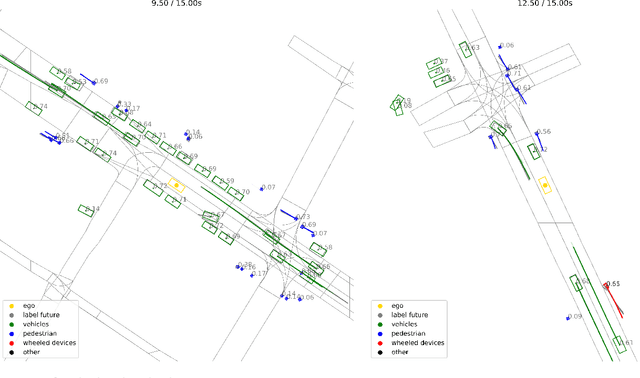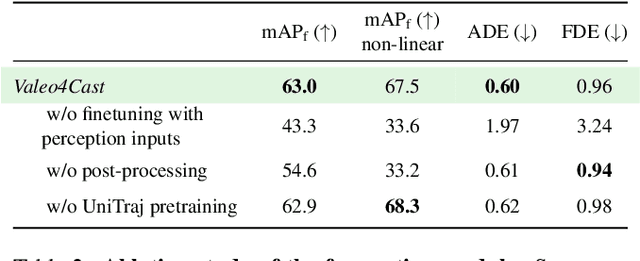Gilles Puy
DANTE
LiDPM: Rethinking Point Diffusion for Lidar Scene Completion
Apr 24, 2025Abstract:Training diffusion models that work directly on lidar points at the scale of outdoor scenes is challenging due to the difficulty of generating fine-grained details from white noise over a broad field of view. The latest works addressing scene completion with diffusion models tackle this problem by reformulating the original DDPM as a local diffusion process. It contrasts with the common practice of operating at the level of objects, where vanilla DDPMs are currently used. In this work, we close the gap between these two lines of work. We identify approximations in the local diffusion formulation, show that they are not required to operate at the scene level, and that a vanilla DDPM with a well-chosen starting point is enough for completion. Finally, we demonstrate that our method, LiDPM, leads to better results in scene completion on SemanticKITTI. The project page is https://astra-vision.github.io/LiDPM .
Clustering is back: Reaching state-of-the-art LiDAR instance segmentation without training
Mar 17, 2025Abstract:Panoptic segmentation of LiDAR point clouds is fundamental to outdoor scene understanding, with autonomous driving being a primary application. While state-of-the-art approaches typically rely on end-to-end deep learning architectures and extensive manual annotations of instances, the significant cost and time investment required for labeling large-scale point cloud datasets remains a major bottleneck in this field. In this work, we demonstrate that competitive panoptic segmentation can be achieved using only semantic labels, with instances predicted without any training or annotations. Our method achieves performance comparable to current state-of-the-art supervised methods on standard benchmarks including SemanticKITTI and nuScenes, and outperforms every publicly available method on SemanticKITTI as a drop-in instance head replacement, while running in real-time on a single-threaded CPU and requiring no instance labels. Our method is fully explainable, and requires no learning or parameter tuning. Code is available at https://github.com/valeoai/Alpine/
UNIT: Unsupervised Online Instance Segmentation through Time
Sep 12, 2024Abstract:Online object segmentation and tracking in Lidar point clouds enables autonomous agents to understand their surroundings and make safe decisions. Unfortunately, manual annotations for these tasks are prohibitively costly. We tackle this problem with the task of class-agnostic unsupervised online instance segmentation and tracking. To that end, we leverage an instance segmentation backbone and propose a new training recipe that enables the online tracking of objects. Our network is trained on pseudo-labels, eliminating the need for manual annotations. We conduct an evaluation using metrics adapted for temporal instance segmentation. Computing these metrics requires temporally-consistent instance labels. When unavailable, we construct these labels using the available 3D bounding boxes and semantic labels in the dataset. We compare our method against strong baselines and demonstrate its superiority across two different outdoor Lidar datasets.
Train Till You Drop: Towards Stable and Robust Source-free Unsupervised 3D Domain Adaptation
Sep 06, 2024Abstract:We tackle the challenging problem of source-free unsupervised domain adaptation (SFUDA) for 3D semantic segmentation. It amounts to performing domain adaptation on an unlabeled target domain without any access to source data; the available information is a model trained to achieve good performance on the source domain. A common issue with existing SFUDA approaches is that performance degrades after some training time, which is a by product of an under-constrained and ill-posed problem. We discuss two strategies to alleviate this issue. First, we propose a sensible way to regularize the learning problem. Second, we introduce a novel criterion based on agreement with a reference model. It is used (1) to stop the training when appropriate and (2) as validator to select hyperparameters without any knowledge on the target domain. Our contributions are easy to implement and readily amenable for all SFUDA methods, ensuring stable improvements over all baselines. We validate our findings on various 3D lidar settings, achieving state-of-the-art performance. The project repository (with code) is: github.com/valeoai/TTYD.
MILAN: Milli-Annotations for Lidar Semantic Segmentation
Jul 22, 2024



Abstract:Annotating lidar point clouds for autonomous driving is a notoriously expensive and time-consuming task. In this work, we show that the quality of recent self-supervised lidar scan representations allows a great reduction of the annotation cost. Our method has two main steps. First, we show that self-supervised representations allow a simple and direct selection of highly informative lidar scans to annotate: training a network on these selected scans leads to much better results than a random selection of scans and, more interestingly, to results on par with selections made by SOTA active learning methods. In a second step, we leverage the same self-supervised representations to cluster points in our selected scans. Asking the annotator to classify each cluster, with a single click per cluster, then permits us to close the gap with fully-annotated training sets, while only requiring one thousandth of the point labels.
Valeo4Cast: A Modular Approach to End-to-End Forecasting
Jun 12, 2024



Abstract:Motion forecasting is crucial in autonomous driving systems to anticipate the future trajectories of surrounding agents such as pedestrians, vehicles, and traffic signals. In end-to-end forecasting, the model must jointly detect from sensor data (cameras or LiDARs) the position and past trajectories of the different elements of the scene and predict their future location. We depart from the current trend of tackling this task via end-to-end training from perception to forecasting and we use a modular approach instead. Following a recent study, we individually build and train detection, tracking, and forecasting modules. We then only use consecutive finetuning steps to integrate the modules better and alleviate compounding errors. Our study reveals that this simple yet effective approach significantly improves performance on the end-to-end forecasting benchmark. Consequently, our solution ranks first in the Argoverse 2 end-to-end Forecasting Challenge held at CVPR 2024 Workshop on Autonomous Driving (WAD), with 63.82 mAPf. We surpass forecasting results by +17.1 points over last year's winner and by +13.3 points over this year's runner-up. This remarkable performance in forecasting can be explained by our modular paradigm, which integrates finetuning strategies and significantly outperforms the end-to-end-trained counterparts.
Revisiting the Distillation of Image Representations into Point Clouds for Autonomous Driving
Oct 26, 2023



Abstract:Self-supervised image networks can be used to address complex 2D tasks (e.g., semantic segmentation, object discovery) very efficiently and with little or no downstream supervision. However, self-supervised 3D networks on lidar data do not perform as well for now. A few methods therefore propose to distill high-quality self-supervised 2D features into 3D networks. The most recent ones doing so on autonomous driving data show promising results. Yet, a performance gap persists between these distilled features and fully-supervised ones. In this work, we revisit 2D-to-3D distillation. First, we propose, for semantic segmentation, a simple approach that leads to a significant improvement compared to prior 3D distillation methods. Second, we show that distillation in high capacity 3D networks is key to reach high quality 3D features. This actually allows us to significantly close the gap between unsupervised distilled 3D features and fully-supervised ones. Last, we show that our high-quality distilled representations can also be used for open-vocabulary segmentation and background/foreground discovery.
BEVContrast: Self-Supervision in BEV Space for Automotive Lidar Point Clouds
Oct 26, 2023Abstract:We present a surprisingly simple and efficient method for self-supervision of 3D backbone on automotive Lidar point clouds. We design a contrastive loss between features of Lidar scans captured in the same scene. Several such approaches have been proposed in the literature from PointConstrast, which uses a contrast at the level of points, to the state-of-the-art TARL, which uses a contrast at the level of segments, roughly corresponding to objects. While the former enjoys a great simplicity of implementation, it is surpassed by the latter, which however requires a costly pre-processing. In BEVContrast, we define our contrast at the level of 2D cells in the Bird's Eye View plane. Resulting cell-level representations offer a good trade-off between the point-level representations exploited in PointContrast and segment-level representations exploited in TARL: we retain the simplicity of PointContrast (cell representations are cheap to compute) while surpassing the performance of TARL in downstream semantic segmentation.
Unsupervised Object Localization in the Era of Self-Supervised ViTs: A Survey
Oct 19, 2023Abstract:The recent enthusiasm for open-world vision systems show the high interest of the community to perform perception tasks outside of the closed-vocabulary benchmark setups which have been so popular until now. Being able to discover objects in images/videos without knowing in advance what objects populate the dataset is an exciting prospect. But how to find objects without knowing anything about them? Recent works show that it is possible to perform class-agnostic unsupervised object localization by exploiting self-supervised pre-trained features. We propose here a survey of unsupervised object localization methods that discover objects in images without requiring any manual annotation in the era of self-supervised ViTs. We gather links of discussed methods in the repository https://github.com/valeoai/Awesome-Unsupervised-Object-Localization.
You Never Get a Second Chance To Make a Good First Impression: Seeding Active Learning for 3D Semantic Segmentation
Apr 23, 2023Abstract:We propose SeedAL, a method to seed active learning for efficient annotation of 3D point clouds for semantic segmentation. Active Learning (AL) iteratively selects relevant data fractions to annotate within a given budget, but requires a first fraction of the dataset (a 'seed') to be already annotated to estimate the benefit of annotating other data fractions. We first show that the choice of the seed can significantly affect the performance of many AL methods. We then propose a method for automatically constructing a seed that will ensure good performance for AL. Assuming that images of the point clouds are available, which is common, our method relies on powerful unsupervised image features to measure the diversity of the point clouds. It selects the point clouds for the seed by optimizing the diversity under an annotation budget, which can be done by solving a linear optimization problem. Our experiments demonstrate the effectiveness of our approach compared to random seeding and existing methods on both the S3DIS and SemanticKitti datasets. Code is available at \url{https://github.com/nerminsamet/seedal}.
 Add to Chrome
Add to Chrome Add to Firefox
Add to Firefox Add to Edge
Add to Edge